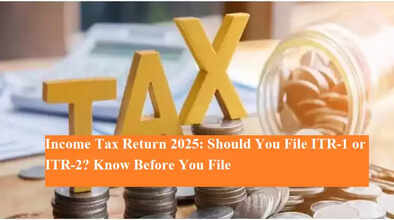Income Tax Return 2025: Should You File ITR-1 or ITR-2? Know Before You File

Filing your Income Tax Return (ITR) using the wrong form can lead to your return being marked as defective by the Income Tax Department. To avoid unnecessary delays or rejections, it is important to understand the difference between ITR-1 and ITR-2, and choose the correct form based on your income type and financial details.
✅ Who Should Use ITR-1?
The ITR-1 form, also known as Sahaj, is meant for resident individuals who have:
-
Income up to ₹50 lakh from salary or pension
-
Income from one house property
-
Other sources of income such as interest from savings or fixed deposits
Note: If your income exceeds ₹50 lakh or you have capital gains, foreign assets, or are a company director, you cannot file ITR-1.
✅ Who Should Use ITR-2?
The ITR-2 form is for individuals and Hindu Undivided Families (HUFs) who do not have income from business or profession but:
-
Have annual income above ₹50 lakh
-
Have capital gains under Section 112A exceeding ₹1.25 lakh
-
Are Directors in a company
-
Have invested in unlisted equity shares
-
Have foreign income or foreign assets
-
Hold foreign bank accounts
If any of the above apply, you must use ITR-2, even if you’re a salaried employee or a pensioner.
📝 Important Update from Income Tax Department
On July 18, 2025, the Income Tax Department released the online utility for ITR-2, making it easier to file returns with pre-filled data. The offline Excel utilities for ITR-2 and ITR-3 were already available earlier. However, the online utility for ITR-3 is still pending.
⚠️ Don’t Wait Until the Deadline
While the last date for filing ITR for FY 2024–25 has been extended from July 31 to September 15, 2025, tax experts warn against waiting till the last moment. Filing early reduces the chance of errors and gives time to rectify any mismatches or discrepancies.
📄 Documents You Must Verify Before Filing ITR
To ensure your ITR filing is accurate, verify the following key documents:
1. Form 16
Issued by your employer, it contains salary details and TDS deducted.
2. Form 26AS
It reflects the tax deducted (TDS), advance tax paid, and high-value financial transactions.
3. Annual Information Statement (AIS)
AIS provides a more detailed view than Form 26AS and includes:
-
Interest earned from savings or fixed deposits
-
Dividend income
-
Rent received
-
Stock market transactions
-
Foreign remittances and other income
Ensure that the data in Form 16, 26AS, and AIS matches to avoid notices from the Income Tax Department.
📌 Summary: When to Use ITR-2 Instead of ITR-1
| Criteria | Use ITR-1 | Use ITR-2 |
|---|---|---|
| Annual income ≤ ₹50 lakh | ✅ | ❌ |
| Income from salary/pension only | ✅ | ✅ |
| Capital gains > ₹1.25 lakh | ❌ | ✅ |
| Director in a company | ❌ | ✅ |
| Unlisted shares | ❌ | ✅ |
| Foreign income/assets | ❌ | ✅ |
Choosing the right ITR form is crucial. If you mistakenly use ITR-1 when ITR-2 applies to you, your return may be rejected or flagged as defective. Verify your income sources, cross-check your documents, and file early to avoid stress later.

